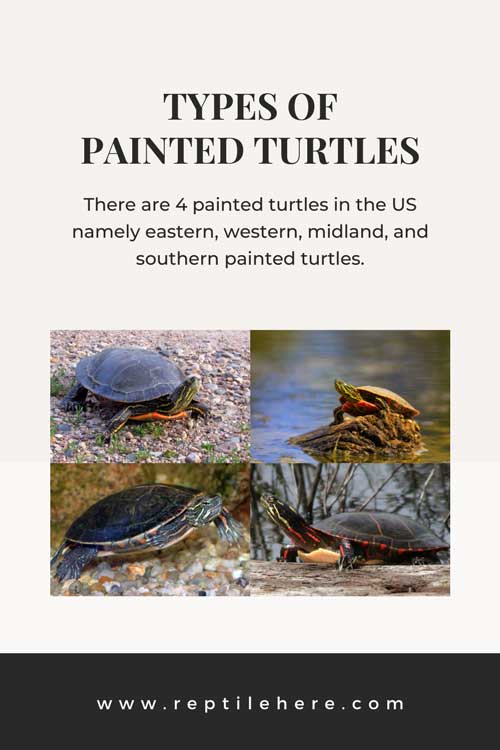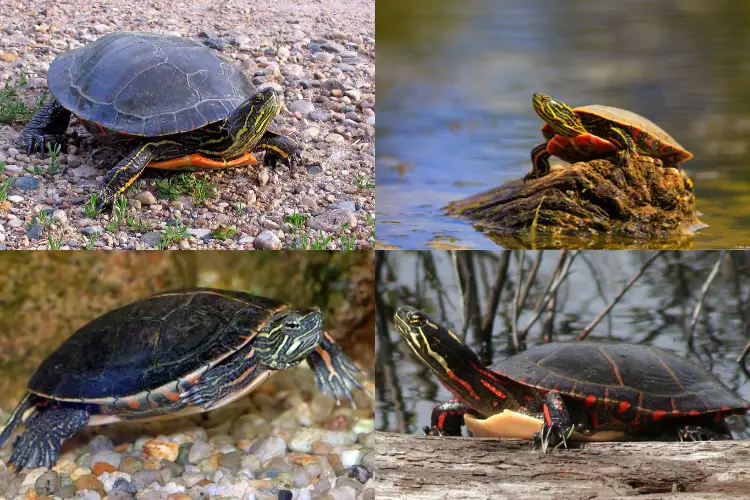Types of Painted Turtles
There are 4 painted turtles in the US namely eastern, western, midland, and southern painted turtles. All of them are native to North America and are named relative to their geographical location.
The main difference between these turtles that sets them apart is their physical differences. Other than that, they share similar feeding, habitat, and other behaviors. The female painted turtles are also generally larger than their male counterparts.
Below, we discuss more details about these 4 painted turtles. For each turtle, you’ll learn the basics such as physical appearance, average adult size, habitat, diet, conservation status, and more.
1. Eastern Painted Turtle
Contents
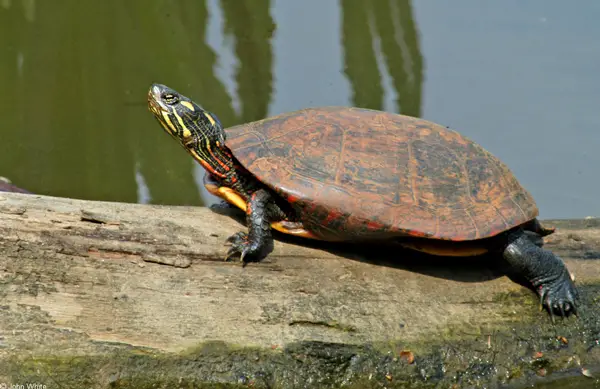
- Scientific name: Chrysemys picta
- Common name: Painted Turtle
- Family: Emydidae
- Size: 4 to 6 inches
- Lifespan: 30 to 50 years
- Conservation status: Least Concern
The Eastern painted turtle is one of the most recognizable turtle species in the US, thanks to its beautiful and unique coloring. The bright reds and yellow-green markings on its shell, head, and limbs are no doubt a beauty to behold!
This painted turtle sub-species has been observed to live near water bodies with minimal movements. Examples include marshes, ponds, slow-moving streams with sandy/muddy bottoms, small lakes, etc.
They also prefer areas with aquatic plants in plenty as they make their primary food source in the wild.
One interesting fact about these turtles is their ability to hold their breath for up to 30 hours when inside temperate water. Moreover, they’re capable of standing dominant in freezing cold waters for up to 4 months.
Unfortunately, it’s not easy to establish the population of these turtles. This is because most people who pet them end up releasing them back into the wild. This contributes to an ever-expanding range plus unstable reproduction rates for these turtles.
2. Western Painted Turtle
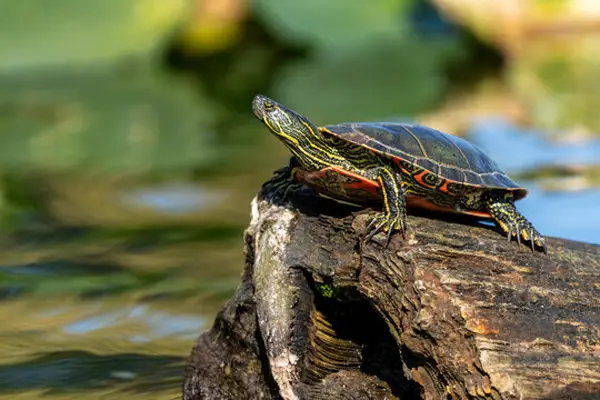
- Scientific name: Chrysemys picta belli
- Common name: Westland Painted Turtle
- Family: Emydidae
- Size: 4 to 10 inches
- Lifespan: 30 to 40 years
- Conservation status: Least Concern
The Western painted turtle is identified by an oval-shaped carapace that lacks a ridge in the middle. The carapace is usually dark olive or black in color.
The lower side of the shell is usually red, with multiple dark markings in the center. And the skin itself is covered with yellow stripes.
Westland painted turtles are aquatic and their webbed feet help propel them in the waters.
The most common habitats for this turtle include slow-moving rivers, shallow streams, and lakes. They choose these areas because they can easily find food.
Given that they’re omnivorous, they feed on aquatic vegetation as well as meat from insects, snails, shrimps, tadpoles, and earthworms.
Their hatchlings are more carnivorous to help take in more proteins for building muscle.
3. Midland Painted Turtle
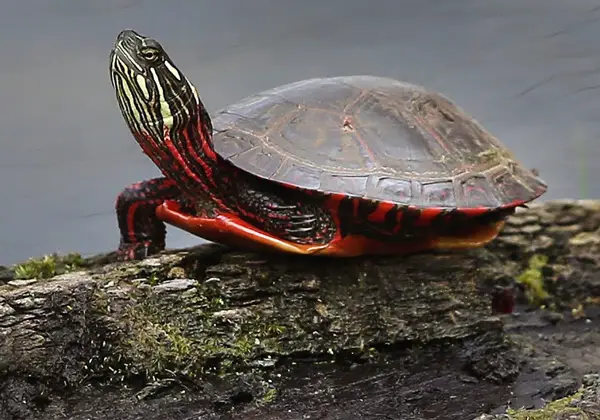
- Scientific name: Chrysemys picta marginata
- Common name: Midland Painted Turtle
- Family: Emydidae
- Size: 4 to 10 inches
- Lifespan: 20 to 40 years
- Conservation status: Least Concern
This is another subspecies of painted turtle you’ll find in various states in the US. Telling this specie apart from other painted turtles can be challenging since it lacks any unique features.
Nonetheless, a typical midland painted turtle has a dark-colored shell and skin that ranges from dark brown to black. Its shell usually features markings on its side, with colors from red to yellow.
The lower side of its shell is usually yellow in color. Don’t forget the skin is usually covered with lines than turn yellowish near the head and then change to red.
Just like the other painted turtles, this species prefers living in freshwater bodies. It can be found in slow-moving rivers, lakes, and ponds.
They’re also omnivorous and like feeding on aquatic vegetation as well as meat from insects, snails, shrimps, tadpoles, and earthworms.
4. Southern Painted Turtle
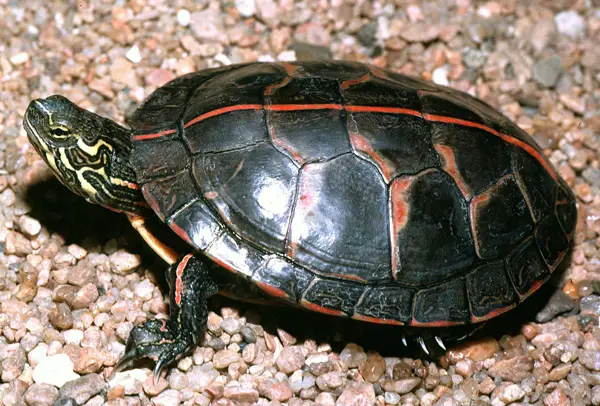
- Scientific name: Chrysemys dorsalis
- Common name: Painted Turtle
- Family: Emydidae
- Size: 4 to 6 inches
- Lifespan: 30 to 50 years
- Conservation status: Least Concern
The Southern painted turtle is a sub-species of painted turtle and the smallest of the painted turtle species in the US. It prefers living in shallow water habits, e.g. the edges of lakes and streams.
The average adult size ranges from 4 to 5 inches and is characterized by a distinctive orange or red stripe running down the back of its shell.
They also feature a plain, pale-yellow skin belly (plastron) that’s sometimes lightly spotted.
Baby southern painted turtles tend to eat more meat and less vegetation. And as they grow up, they concentrate more on vegetation and less on animal matter.
Nonetheless, these turtles are omnivorous, just like other species. Some of the most common foods for this species include algae, duckweed, dragonfly larvae, and young crayfish.
Most folks like keeping these turtles as a pet due to their small size and unique color patterns on their shells.
Not to forget, they can live for quite a long time—up to 50 years—and most pet owners end up releasing them back into the wild.
Final Verdict
The 4 painted turtles found in the US are mostly found in the North American region and are named according to their geographical locations. They include the eastern, western midland, and southern painted turtles.
From this list, it is evident that these turtles have similar feeding habitats. They also reside in freshwater bodies including slow-moving rivers, lakes, and ponds. Females grow to bigger sizes than their male counterparts.
The distinctive physical appearance of each type of painted turtle is what sets them apart and makes them easy to identify.
